//… continuation …//
Igor Grishin: Timur! The beginners are usually taught on the prohibited moves, can you tell us about them?
Timur Saitov: With pleasure, Igor. So, the here are the prohibited moves.
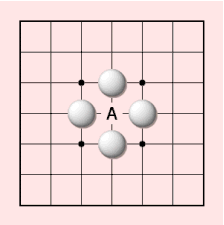
//Diagram 18//
If black puts a stone on the crossing marked A, it will appear for us that it is already captured and should be taken off the board. This kind of move is a “suicide” and is prohibited. But…
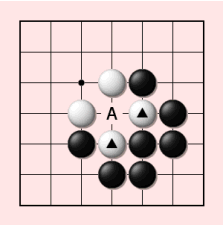
//Diagram 19//
… if we change the position a bit, in this situation we see that the stones marked with triangles have only one mutual breathing space. Now, if black puts a stone in the place marked ‘A’ he will capture white stones (see Diagram 20).

//Diagram 20//
The two white stones become prisoners and are taken off the board.
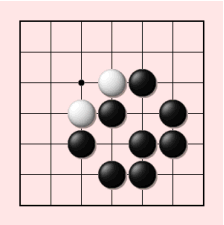
//Diagram 21//
It appears now that a “prohibited move” is allowed if you capture your opponent’s stones (one or some – it doesn’t matter).
Igor Grishin: Thanks, Timur! Then tell us, please, about eyes. What is it?
Timur Saitov: Two eyes is an attribute of a group that can’t be captured.
Now, when we know that with some particular circumstances prohibited moves are allowed , it would seem to us that any group can be captured, but it’s not so. There are groups of stones in Go that can’t be captured. Let’s take a look at the group of stones in Diagram 22.
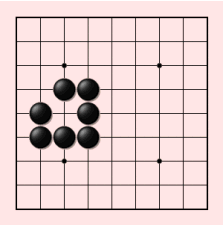
//Diagram 22//
Theoretically it can be surrounded with white stones like in Diagram 23
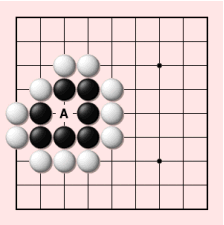
//Diagram 23//
… and after putting a white stone in the only vacant point …
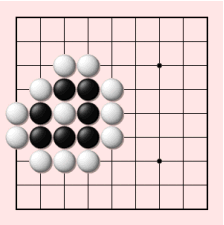
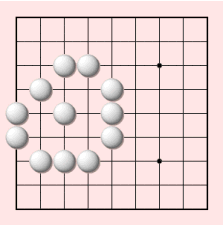
//Diagram 24//
…the whole black group will be taken off the board.
Igor Grishin: Such point is called “an eye”.
Timur Saitov: Yes, you are right, Igor. Now let’s add some more stones to this group.
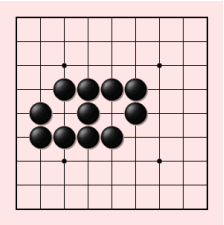
//Diagram 25//
White can surround such group, if black plays somewhere else and do not answer the white’s moves. (Diagram 26).
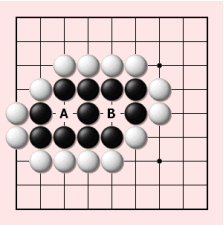
//Diagram 26//
But to capture this group one should put stones both at A and B points. If white moves at A blacks still have a breathing point at B which means that you can’t move at A. This is a prohibited move, as if white moves at A he does not capture anything. So, to capture this group you should make two prohibited moves. Unfortunately, you can’t do that according to the rules of Go. Consequently, this group can’t be captured. They say about such group that it has two eyes. A group with two eyes can’t be captured and taken off the board in any way.
Igor Grishin: Yes, Timur, eyes is a special feature of Go. You told us about it simply and precisely.
Timur Saitov: It was a pleasure for me to tell you about eyes, as they give life to stones in Go. Here are some examples of groups with “two eyes”. I placed them on an empty board; and without any – of white stones (Diagram 27). Academically, I should say. But I hope that the reader will understand that it’s not necessary to build eyes without any threatening opponent’s stones in the neighborhood. This is done, so to say, in case of emergency.

//Diagram 27//
Igor Grishin: There are real eyes and false eyes…
Timur Saitov: Yes! I think it will be very interesting for our readers to get to know about the so called false eyes.
Question. Does the group in Diagram 28 have two eyes?
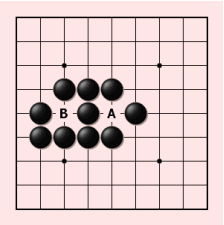
//Diagram 28//
In B point there is an eye no doubt. It seems as in A there is another one.
But, is it an eye?
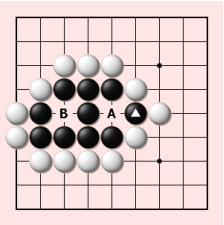
//Diagram 29//
If white surrounds the black group we will see that a stone, marked with a triangle, is under a threat of being taken off.

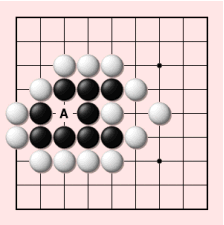
//Diagram 30//
Indeed, the stone can be captured by white. Consequently, now with move B…
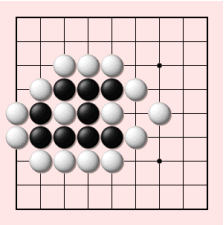
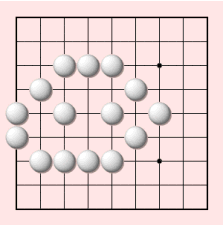
//Diagram 31//
… white can take off the whole group.
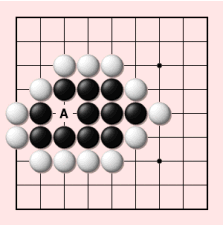
//Diagram 32//
If black connects they will have only one eye left at B, this means capturing as well.
//… to be continued …//

